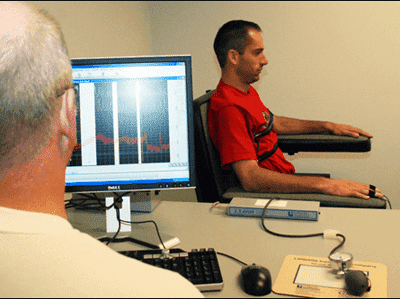WHAT IS IT LIKE TO TAKE A POLYGRAPH EXAMINATION?
WHAT IS IT LIKE TO TAKE A LIE DETECTOR TEST?

You are invited into the exam room, which is usually quite plain. Not much on the walls except for a few nondescript pictures. On the table in front of you is a laptop computer with a number of wires and tubes attached, all laid out neatly on the flat surface. The examiner greets you pleasantly and shakes your hand, then asks if you have ever taken a polygraph exam before. You respond that you have not. You are invited to sit down in a chair facing the examiner. This exam – like most polygraphs – is also being recorded with a video or audio recorder, which you understand is part of the process.
“My name is Terry Smith and I will be your examiner today. First let me tell you something about myself.” The examiner proceeds to give you some background on his/her experience, education, and other credentials.
The Pretest Introduction
“Now I’m going to explain to you what we’ll be doing today. This exam will take about 2 hours, so please make yourself comfortable. If you need to take a break to use the rest room, just let me know. If you would like some water, I’ll get some for you. The first thing I’m going to do is find out some things about you, including some medical history, psychological treatments, medications, or anything else that might affect your exam. After that I’m going to teach you some things about polygraph so that you have an understanding of what this equipment does. Next, we’ll be discussing the reason that you are here, and I will give you an opportunity to explain anything you may know about this missing money. Once you’ve told me what you can, I will design a series of “yes” and “no” questions to verify some of the things that you have told me. I will program these questions into my computer, and then read to you every question that I plan to ask you on this exam. There can be no surprises on a polygraph exam, so I have to make sure that you aren’t surprised by any of my questions and that you understand every one of the questions on this exam. After we have reviewed these questions together, I will attach you to the polygraph and ask you the exact same questions again. We will go through this series of questions anywhere from 3 to 6 times to make sure we collect enough data to make a good decision. The only part of this exam you may find uncomfortable is the blood pressure cuff which will be inflated for about 5 minutes at a time, and your arm may start to fall asleep during this process. It will not hurt you and your arm will feel fine as soon as the test is over. Do you have any questions about what we’ll be doing today?”
You respond that you don’t have any questions right now, but you’re worried that being nervous will affect your test. The examiner assures you that you are expected to be nervous, and that you will be nervous throughout the entire exam. “Polygraph doesn’t even measure nervousness,” you are told. And that is the truth.
After you sign some release forms, the examiner begins to ask questions about your background… health condition, medications, hospitalizations, the kind of work you do, where you live, how much sleep you’ve had, your criminal history, and much more. You realize how thorough this interview is going to be. You worry a little bit about the pot you smoked last weekend, but the examiner assures you that it won’t affect your test or whether you stole the missing money.
“Now I’m going to tell you how a polygraph test works. Our bodies are controlled by the Autonomic Nervous System, which takes care of the routine functions of your body like your heart beat, breathing, body temperature, and so on. You don’t have a lot of conscious control over this part of your body. It works pretty much on its own. When your body needs to adjust something to keep you safe and comfortable, it does so all by itself. For example, if you step outside where it’s 95 degrees, your body temperature will start to go up. To keep you healthy and comfortable, a part of your body called the Sympathetic Nervous System (SNS) activates that glands of your skin to help bring down your body temperature. This is the way your body keeps itself healthy and comfortable. When you exercise, your body recognizes that your muscles are being used, and muscles need “fuel” to work their best. This “fuel” comes through the blood supply, so when you exercise, the SNS speeds up your heartbeat to get more of this fuel to your muscles where it’s needed. So the SNS makes the changes to your body to keep it safe, comfortable and protected, and it is the SNS that the polygraph will be recording today. In a little while you will be attached to the polygraph and I will ask you a series of questions. I will be watching how your SNS responds when you are being asked these questions. This is not a part of your body that you have much control over, so your body will give me information about what’s going on whether you want it to or not.”
The examiner continues. “Our bodies have a unique way of protecting themselves whenever we are threatened or put in danger. For example, if you are walking along a trail and see a rattlesnake on the trail in front of you, you body will have a reaction to that snake being there. The reason you have this reaction is that your brain sees this snake as a potential threat – it could possible hurt you – and your body then wants to try and protect you from that. Your SNS makes some changes to help prepare you for whatever you might need to do to avoid that danger. Adrenaline is released into your system, more blood is sent to your muscles in case they are needed, your digestive process slows down, your breathing changes, and the glands of your skin become more active. This is the way our bodies naturally respond when we are faced with danger. This is also how the polygraph works. I’ll explain.”
“When someone tells a lie on a polygraph, it is usually for one reason. They did something wrong. If they get caught doing that “something wrong” they will be punished for it. Maybe the punishment is going to jail, or maybe losing your job, or just costing you money, whatever the punishment is, you don’t want it. How do you avoid this punishment? You lie about what you did. Lying on a polygraph is simply a way of protecting yourself, of keeping yourself out of danger. Just like in the example with the snake, your brain will try to keep you out of this danger by creating a self-defense response. We will see this response on the polygraph because of way your SNS tries to protect you, and there’s nothing you can do to stop this from happening.”
“Do you have any questions” you are asked.
“No, it all makes sense” you say.
The Pretest Interview
The examiner now begins to discuss your case, and you tell the examiner that you don’t know anything about the missing money. Well, that isn’t entirely true. You did hear a rumor about one particular employee who was having financial problems and had asked you to lend him some money on the morning this money disappeared from the boss’s desk. You decide to tell the examiner what you heard, and now your conscience is clear and you are sure there is nothing more you know about this situation. The examiner then makes sure you aren’t the kind of person who would steal the missing money by asking about prior thefts, criminal acts, and other kinds of similar behaviors. You are pretty sure you haven’t done anything too serious in your past, so these questions don’t bother you too much.
Next, the examiner programs all the test questions into the computer and proceeds to read to you all the questions you will be asked on the test. You are feeling more comfortable now that you know you won’t have to answer any really embarrassing questions, but are still a bit nervous that the test could be wrong and that you will be falsely accused of the crime. Then you realize that everyone who has ever taken a polygraph probably feels the same way.
The Testing Phase
The examiner now asks you to move to the examination chair. Some rubber tubes are placed around your chest and abdomen. These will record your breathing. A blood pressure cuff is wrapped around your upper arm. This will record changed in blood pressure and pulse. Some leads are attached to your hand, either to the fingers or the palm. These will record changes in how active your skin glands become. There are also pads that you may be sitting on (or resting your arms or feet on) to record any kind of movement or muscle contractions during the exam. You are facing away from the examiner – toward a blank wall – so that you will not be distracted by anything during the exam.
It is explained to you that you must sit perfectly still during the exam, with the exception of breathing and answering the questions. You are instructed to look straight ahead. Your blood pressure cuff is inflated with air, and you are informed that the first exam will now begin.
The examiner proceeds to ask you the exact same questions as were read to you before, and you answer them easily because you have already answered them. During the first question sequence, you had an itch and moved slightly in your chair. The examiner saw this and had to remind you to sit still. About five minutes later – after the first series of questions is completed – the pressure is released from your blood pressure cuff you are given a few minutes to rest. This process continues for 3 more runs through the same questions as before. Finally, the examiner removes the blood pressure cuff from your arm, which was beginning to fall asleep.
The Post-Test Interview
After looking at your charts, the examiner tells you that you passed your polygraph exam and that you are free to go.
If there had been a problem, the examiner would have asked you why you believe you failed your exam. In many cases you are given an opportunity to explain why you had a problem. This could be because you stole the money, or could also be because you know more about missing money than you admitted to. This is your final chance to offer an explanation before the test is concluded.
If the test was inconclusive (the examiner can’t make a decision one way or the other) you may be asked to take a break and return for a new series of questions so that the examiner can collect more data and hopefully score your exam conclusively.
Footnote
The foregoing scenario is somewhat simplified from an actual polygraph (lie detector) exam but does follow the general guidelines of what is involved in the testing procedure. This procedure can take anywhere from 1 to 3 hours from beginning to end. Although there are established protocols for polygraph testing, many examiners will use variations of the basic technique based on personal experience and preference.

